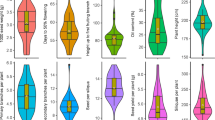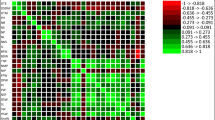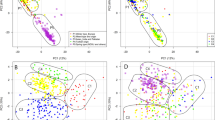Summary
Jinks and Pooni (1979) showed that when a single linear regression fails, two intersecting linear regressions are the most widely applicable model of the relationship between the interaction of genotype and environment and the additive environmental value ej. In theory two overlapping linear regressions should be a more appropriate model where many factors contribute to the interaction. We have therefore compared the goodness-of-fit of models based upon linear, quadratic, two overlapping linear and two intersecting linear regressions to the final heights of 81 inbred lines derived from the cross of varieties 1 and 5 of Nicotiana rustica raised in 15 environments, and of 60 inbred lines derived from the cross of varieties 2 and 12 of the same species raised in 14 environments. As controls, the same models have to be fitted to varieties 1 and 5 and their F1 and varieties 2 and 12 and their F1, raised in the majority of these environments.
The results of these analyses confirm the strictly linear relationships previously reported for varieties 1 and 5 and their F1. But as a result of segregation at many loci non-parental kinds of non-linear relationships occur among the inbred lines derived from this cross. They also confirm that for varieties 2 and 12 and their F1 two intersecting linear regressions provide the best fitting model of their responses to environmental differences. Among the inbred lines from this cross are found segregants with non-parental kinds of linear and quadratic relationships. Of the five regression models examined two intersecting linear regressions provide the best fitting model for the largest number of genotypes.
Similar content being viewed by others
Article PDF
References
Boughey, H, and Jinks, J L. 1978. Joint selection for both extremes of mean performance and of sensitivity to a macro-environmental variable. III. The determinants of sensitivity. Heredity, 40, 363–369.
Boughey, H, Jinks, J L, Coombs, D, and Shufflebotham, W. 1978. Joint selection for both extremes of mean performance and sensitivity to a macro-environmental variable. IV. Growth pattern and sensitivity. Heredity, 41, 175–183.
Bucio Alanis, L. 1966. Environmental and genotype-environmental components of variability. I. Inbred lines. Heredity, 21, 387–397.
Bucio Alanis, L, Perkins, J M, and Jinks, J L. 1969. Environmental and genotype-environmental components of variability. V. Segregating generations. Heredity, 24, 399–405.
Goldfeld, S M, and Quandt, R E. 1972. Non linear methods in Econometrics. North Holland Publishing Co., Amsterdam.
Jayasekara, N E M. 1974. Analysis of interactions in Nicotiana rustica. Ph.D thesis, University of Birmingham.
Jinks, J L, Caten, C E, Simchen, G, and Croft, J H. 1966. Heterokaryon incompatibility and variation in wild populations of Aspergillus nidulans. Heredity, 21, 227–239.
Jinks, J L, Jayasekara, N E M, and Boughey, H. 1977. Joint selection for both extremes of mean performance and of sensitivity to a macro-environmental variable. II. Single seed descent. Heredity, 39, 345–355.
Jinks, J L, and Pooni, H S. 1976. Predicting the properties of recombinant inbred lines derived by single seed descent. Heredity, 36, 253–266.
Jinks, J L, and Pooni, H S. 1979. Non-linear genotype × environmental interactions arising from response thresholds. I. Parents, F1's and Selections. Heredity, 43, 57–70.
Jinks, J L, and Pooni, H S. 1980. Comparing predictions of mean performance and environmental sensitivity of recombinant inbred lines based upon F3 and triple test cross families. Heredity. (In press).
Mather, K. 1975. Genotype × environment interactions. II. Some genetical considerations. Heredity, 35, 31–53.
Mather, K, and Vines, A. 1952. The inheritance of height and flowering time in a cross of Nicotiana rustica. Quantitative Inheritance, eds. E. C. R. Reeve and C.N. Waddington, pp. 49–80, H.M.S.O., London.
Perkins, J M, and Jinks, J L. 1973. The specificity of the interactions of genotypes with contrasting environments. Heredity, 26, 203–211.
Pooni, H S, Jinks, J L, and Pooni, G S. 1980. A general method for the detection and estimation of additive, dominance and epistatic variation for metrical traits. IV. Triple test cross analysis for normal families and their selfs. Heredity, 44, 177–192.
Yates, F, and Cochran, W G. 1938. The analysis of groups of experiments. Agric Sci, 28, 556–580.
Author information
Authors and Affiliations
Rights and permissions
About this article
Cite this article
Pooni, H., Jinks, J. Non-linear genotype × environment interactions. Heredity 45, 389–400 (1980). https://doi.org/10.1038/hdy.1980.81
Received:
Issue date:
DOI: https://doi.org/10.1038/hdy.1980.81
This article is cited by
-
Evaluating Linear and Non-linear Genotype–Environment Interactions in Pearl Millet
Proceedings of the National Academy of Sciences, India Section B: Biological Sciences (2019)
-
Phenotypic plasticity in Cardamine flexuosa: variation among populations in plastic response to chilling treatments and photoperiods
Oecologia (1995)
-
A parsimonious statistical design and breeding procedure for evaluating and selecting desirable characteristics over environments
Theoretical and Applied Genetics (1993)
-
Linear and non-linear regression analysis of genotype X environment interactions in pearl millet
Theoretical and Applied Genetics (1988)
-
Joint analysis of genotypic and environmental effects
Theoretical and Applied Genetics (1986)



